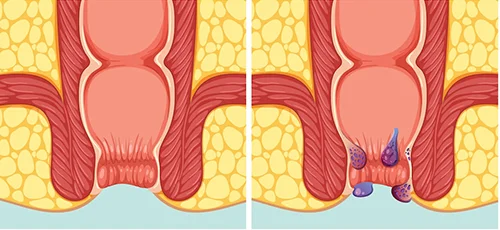Haemorrhoids, also known as piles, are swollen veins located in the lower rectum and anus. They are similar to varicose veins. Haemorrhoids can occur inside the rectum (internal haemorrhoids) or under the skin around the anus (external haemorrhoids). Internal haemorrhoids are usually painless but can cause bleeding during bowel movements. External haemorrhoids, on the other hand, can be painful and are often accompanied by swelling and irritation.
Degrees of Haemorrhoids
There are four types of degrees based on their severity and the extent of prolapse:

- First degree piles are bleeding internal piles.
- Second degree piles show a lump surrounding the anus and are protruding after bowel motion and go away after.
- Third degree piles show a lump surrounding the anus that protrudes after a bowel motion, however, it requires pushing it back by a finger into the anus.
- Fourth degree piles show a lump that is unable to push back into the anus.
Each degree of haemorrhoids (piles) indicates the condition’s progression and helps guide the appropriate treatment approach.
Causes of Haemorrhoids
Many risk factors can cause haemorrhoids, which include:
- Constipation or diarrhoea.
- Pressure exerted by the growing foetus and during labour on the blood vessels surrounding the anus during pregnancy.
- Excessive straining when passing stools.
- Prolonged sitting on the toilet after a period of time.
Alternative factors that can increase the occurrence of haemorrhoids Include:
- Being overweight.
- Having a family history of haemorrhoids.
- Having an intra-abdominal or pelvic tumour (uncommon cause).
- Lack of fibre in the diet.
Symptoms of Haemorrhoids

Symptoms of haemorrhoids vary depending on whether they are internal or external
Internal haemorrhoids lie inside the rectum. You usually cannot see or feel them, and they rarely cause discomfort. Symptoms of internal haemorrhoids:
- Painless bleeding during bowel movements.
- The feeling of not fully emptying the bowels.
- Internal haemorrhoids can prolapse or extend outside the anus, causing discomfort and irritation
External haemorrhoids are located under the skin around the anus. They can cause significant discomfort and symptoms such as:
- Itchiness and irritation around the anus.
- Pain during and after bowel movements.
- Swelling and inflammation around the anus.
- Severe pain and formation of a hard lump due to a blood clot.
Thrombosed haemorrhoids occur when a blood clot forms within a haemorrhoid. This results in a hard lump near the anus that is swollen, inflamed, and painful.
- Noticeable blood in your stool can indicate haemorrhoids.
- Persistent itching around the anus is a common symptom.
- A noticeable lump at the anus can indicate haemorrhoids.
Common symptoms for both internal and external haemorrhoids
- Changes in bowel movements (constipation or diarrhoea).
- Changes in the motion of stools.
- Detecting your stools are thinner than normal.
- Unexplainable weight loss and loss of appetite.
The symptoms mentioned above can also indicate colorectal cancer. Consult your doctor for advice and examine thoroughly.
Treatments for Haemorrhoids
The treatment of haemorrhoids depends largely on their severity, with options ranging from simple home remedies to surgery.
Non-surgical treatments
Non-surgical treatments are typically recommended for managing mild to moderate haemorrhoids. These include:
- Increase your fibre and water intake to avoid strain during bowel movements.
- Over-the-counter medications such as pain relievers, creams, ointments, and suppositories can relieve pain, swelling, and inflammation. These treatments are suitable for reducing symptoms of smaller, less severe haemorrhoids.
- Rubber band ligation (ligation) is performed to treat first- or second-degree haemorrhoids. A rubber band is put over the piles to block its blood supply, causing it to shrink and eventually fall off.
- A device that can be inserted to enter the anus and to block the blood vessels from transporting blood to the haemorrhoids.
- Sclerotherapy is a procedure where a chemical solution is used in the haemorrhoids, which causes them to shrink and fall of.
Surgical Treatments
Surgical options are considered when haemorrhoids are large, severe, or do not respond to non-surgical treatments. These include:
- Haemorrhoidectomy is a removal surgical procedure that blocks off the third- and fourth-degree piles. The surgery can be done under general anaesthesia and involves cutting away the haemorrhoids.
- Haemorrhoid stapling procedure treats prolapsed haemorrhoids and involves stapling the haemorrhoid tissue back into place inside the rectum, which also cuts off the blood supply so the tissue will shrink and be reabsorbed.
Each of these treatment options, whether non-surgical or surgical, has its indications based on the symptoms and severity of the haemorrhoids.
Early intervention with non-surgical methods is often effective, but persistent or severe cases may require surgical approaches to relieve and prevent complications. Always consult a healthcare provider to determine the most appropriate treatment for your condition.
Preventing Haemorrhoids
Implementing the following preventive measures can significantly reduce the risk of developing haemorrhoids.
- Eat plenty of high-fibre foods and drink lots of fluids to keep stools soft.
- Do not strain or sit on the toilet for long periods.
- Clean the area with damp toilet paper or moist towels after bowel movements.
- Engage in regular physical activity to maintain regular bowel movements.
- Avoid long periods of sitting or standing and heavy lifting.
- Maintain a healthy weight to decrease pressure on rectal and anal veins.
- Reduce intake of alcohol and caffeine to prevent constipation.
When to See a Doctor
If you experience bleeding during bowel movements or if your haemorrhoids symptoms do not improve such as pain, itching, or bleeding, seek help to get the diagnosis and treatment you need for relief.
Schedule a consultation with a gastroenterologist today at your nearest Gleneagles Hospital



